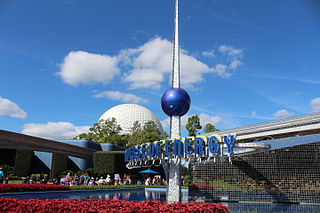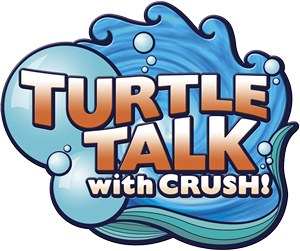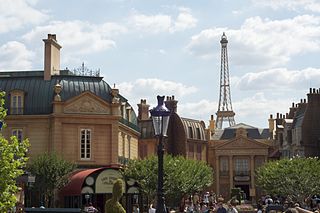
Epcot, stylized in all uppercase as EPCOT, is a theme park at the Walt Disney World Resort in Bay Lake, Florida. It is owned and operated by The Walt Disney Company through its Experiences division. Inspired by an unrealized concept of the same name developed by Walt Disney, the park opened on October 1, 1982, as EPCOT Center, and was the second of four theme parks built at Walt Disney World. The park spans 305 acres, more than twice the size of Magic Kingdom. Often referred to as a "permanent world's fair", Epcot is dedicated to the celebration of human achievement, particularly technological innovation and international culture.

Audio-Animatronics is the registered trademark for a form of robotics animation created by Walt Disney Imagineering for shows and attractions at Disney theme parks, and subsequently expanded on and used by other companies. The robots move and often synchronise with audio by the assistance of an external sound system on the stage.

Walt Disney's Carousel of Progress is a rotating theater audio-animatronic stage show attraction in Tomorrowland at the Magic Kingdom theme park at the Walt Disney World Resort in Bay Lake, Florida just outside of Orlando, Florida. Created by Walt Disney and WED Enterprises as the prime feature of the General Electric (GE) Pavilion for the 1964 New York World's Fair, the attraction was moved to Tomorrowland at Disneyland in Anaheim, California as Carousel of Progress, and remained there from 1967 until 1973. It was replaced in Disneyland by America Sings in 1974, and reopened in its present home in the Magic Kingdom in 1975.

Walt Disney Imagineering Research & Development, Inc., commonly referred to as Imagineering, is the research and development arm of The Walt Disney Company, responsible for the creation, design, and construction of Disney theme parks and attractions worldwide. The company also operates Disney Live Entertainment and The Muppets Studio and manages Disney's properties, from Walt Disney Studios in Burbank to New Amsterdam Theatre and Times Square Studios Ltd. in New York City. Founded by Walt Disney to oversee the production of Disneyland, it was originally known as Walt Disney, Inc. then WED Enterprises, from the initials meaning "Walter Elias Disney", the company co-founder's full name. Headquartered in Glendale, California, Imagineering is composed of "Imagineers", who are illustrators, architects, engineers, lighting designers, show writers and graphic designers.
Jerry W. Rees is an American film director and animator, best known for the Emmy-nominated animated feature film The Brave Little Toaster (1987) and creating many of the visual effects for the cult classic Tron (1982).

World of Motion, presented by General Motors, was the former occupant of the transportation pavilion in Epcot at Walt Disney World Resort. It was an opening day attraction at EPCOT Center in 1982 and it closed in 1996 to make way for Test Track, a new thrill ride through a GM testing facility.

Maelstrom was a reversing Shoot the Chute dark ride attraction located in the Epcot theme park at Walt Disney World Resort in Florida. Designed by Walt Disney Imagineering, the ride opened on July 5, 1988, in the Norway Pavilion of the park's World Showcase section. It was a mix between a log chute and a traditional film attraction. Visitors rode boats patterned after longships that passed through various scenes that featured audio-animatronic figures. The attraction was originally supposed to be called SeaVenture, with the entrance sign during construction even displaying it as such. Sometime between March 1988 and the ride's opening, it was changed.

The Wonders of Life pavilion was an attraction at Epcot at Walt Disney World in Lake Buena Vista, Florida. It was devoted to health care, focusing on the human body, physical fitness, medicine and nutrition. Attractions included Body Wars and Cranium Command. It is located inside a golden colored dome between Mission: SPACE and Wonders of Xandar. It opened on October 19, 1989, and closed on January 1, 2007. From 2007 to 2018, the Pavilion acted as EPCOT's Festival Center, before becoming a construction site in March 2019 in preparation for the upcoming Play! Pavilion to replace it.

The Universe of Energy was a pavilion on the eastern side of Future World at Epcot, a theme park at the Walt Disney World Resort in Bay Lake, Florida. One of Epcot's opening day attractions in 1982, it explored the world of energy through four large-format film presentations and a slow-moving dark ride through a jungle diorama filled with audio-animatronic dinosaurs. In 1996, it was updated as Ellen's Energy Adventure, starring Ellen DeGeneres and Bill Nye.

Gary Trousdale is an American animator, film director, screenwriter and storyboard artist. He is best known for directing films such as Beauty and the Beast (1991), The Hunchback of Notre Dame (1996), and Atlantis: The Lost Empire (2001). He frequently works with Kirk Wise and Don Hahn.

Turtle Talk with Crush is an interactive talk show type attraction that has appeared at several of the Disney theme parks. It first opened on November 16, 2004 at The Living Seas pavilion at Epcot and later at Disney California Adventure in July 2005. The attraction opened in Hong Kong Disneyland from May 24 to August 10, 2008 as part of the "Nonstop Summer Fun" celebration. The attraction also opened in Tokyo DisneySea on October 1, 2009.
"There's a Great Big Beautiful Tomorrow" is the theme song to two Disney attractions, Walt Disney's Carousel of Progress at the Magic Kingdom of Walt Disney World and Innoventions at Disneyland. It was also used in one scene of the Epcot attraction Horizons.

The France Pavilion is a French-themed pavilion that is part of the World Showcase within Epcot at Walt Disney World in Bay Lake, Florida. Its location is between the Morocco and United Kingdom pavilions.

The American Adventure is the host pavilion of the World Showcase within Epcot at Walt Disney World in Bay Lake, Florida, United States. It is also the name of the Colonial American-themed pavilion's main attraction, an Audio-Animatronics stage show of American history. It is located between the Italy and Japan pavilions.

Gran Fiesta Tour Starring The Three Caballeros is a musical dark boat ride housed within the pyramid-shaped Mexico Pavilion, at the Epcot theme park at the Walt Disney World Resort in Florida. It was the first World Showcase attraction to feature Disney characters based on an existing property. Norway followed suit in 2014 when it closed its Maelstrom ride to make room for Frozen Ever After, which opened in 2016.

Muppet Mobile Lab is a free-roving, audio-animatronic entertainment attraction designed by Walt Disney Imagineering, that has been tested at Disney California Adventure Park in Anaheim, California, at Walt Disney World in Orlando, Florida and at Hong Kong Disneyland in Hong Kong.

Waking Sleeping Beauty is a 2009 American documentary film directed by Disney film producer Don Hahn and produced by Hahn and former Disney executive Peter Schneider. The film documents the history of Walt Disney Feature Animation from 1984 to 1994, covering the rise of a period referred to as the Disney Renaissance.

Frozen Ever After is a musical reversing Shoot the Chute dark ride in Epcot at the Walt Disney World Resort. Part of the Norway Pavilion of the Epcot's World Showcase section, the attraction features scenes inspired by Disney's animated film Frozen as well as the 2015 animated short Frozen Fever. It opened on June 21, 2016, using the ride vehicles and track layout of the former Maelstrom attraction. A version of the attraction opened at Hong Kong Disneyland on November 20, 2023, as part of The Walt Disney Company's centennial celebration, with two more scheduled to open at Tokyo DisneySea on June 6, 2024 and Walt Disney Studios Park in the second half of 2025.

Play! is an upcoming pavilion which is set to open in Epcot's World Discovery area. Originally planned to open in 2021, the attraction missed its opening window without any formal announcement of a delay. In January 2023, Play! was removed from EPCOT guide maps following over three years without the attraction being mentioned by Disney. Later that month, Disney officially announced that the attraction's concept was being reevaluated. As originally announced, Play was set to be constructed within the former Wonders of Life pavilion and themed as an interactive futuristic city where guests would be able to interact with a variety of Disney characters.


















